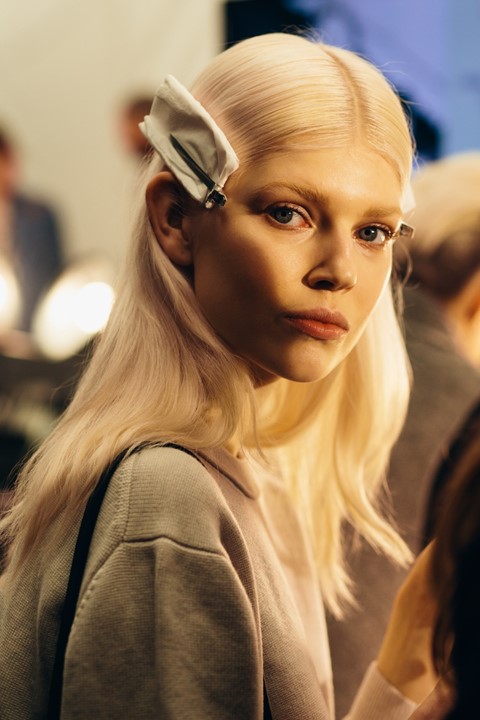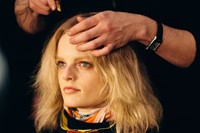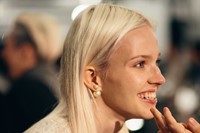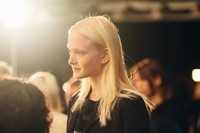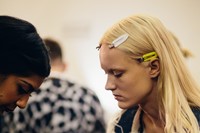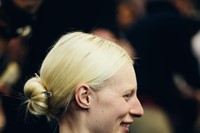In celebration of the New York blonde moment, here we present our favourite 10 blonde facts
While there are plenty of column inches dedicated to the Wang wellies, streakers and the MBMJ debut, the steady flurry of blonde models at New York fashion week has slipped by, unnoted. Not at AnOther though, with our photographer David Urbanke capturing candid shots of beautiful pale blondes backstage at Victoria Beckham and Tommy Hilfiger.
Blonde hair has had an interesting role in history. It's fair to say they've got a pretty bad rep: in ancient Greece it was associated with prostitution, while the Middle Ages' depictions of Eve consistently gave her free-flowing locks of golden blonde hair that marked her as an evil temptress. However Hollywood helped rehabilitate the blonde,with the glowing manes of Jean Harlow, Marilyn Monroe, Brigitte Bardot, Tippi Hedren and Grace Kelly making it the shade of choice for all aspiring cinematic sirens. AnOther has always supported blonde beauties, and has featured Pamela Anderson, Gwyneth Paltrow, Uma Thurman, Scarlett Johansson and Léa Seydoux on the cover of previous issues.
In celebration of the New York blonde moment, here we present our favourite 10 blonde facts.
1. The word “blonde” is derived from several possible sources. Scholars clash on whether it comes from the Medieval Latin word "blundus", meaning “yellow,” the Old Frankish "blund", meaning “grey haired” or “to mix,” or from the Old English "beblonden", meaning “dyed.”
2. Blonde hair is found adorning the heads of multiple fairy tale heroines, including Rapunzel, Cinderella, Goldilocks and the hair of gold spun by the Miller's daughter in Rumpelstiltskin. In fairy tales, blonde hair often suggests strength, untarnished beauty, indestructibility, youth and high value.
3. In 1886, Elisabeth Nietzsche, sister of the famous philosopher, and friend of Richard Wagner, travelled with her husband, Bernhard Forster, and a select group of blond-haired, blue-eyed Germans to the remote Paraguayan wilderness to found an Aryan colony called Nueva Germania.
"The perfect ‘woman of mystery’ is one who is blonde, subtle and Nordic..." – Alfred Hitchcock
4. In ancient Rome, women would try to dye their hair blonde using pigeon dung, while in Renaissance Venice, they used horse urine. Hydrogen peroxide was discovered in 1818, but there was little application for it until 1867, when it was discovered that it could bleach hair. Hollywood's first blonde goddess, Jean Harlow, was known to dye her hair with a mixture of peroxide, household bleach, soap flakes, and ammonia until it fell out and she was forced to wear a wig.
5. Marilyn Monroe, who starred in the 1953 classic Gentleman Prefer Blondes (based on Anita Loos' novel from 1925) once said, "I like to feel blonde all over." However, she was not a natural blonde and refused to have other blonde actresses on set with her.
6. Alfred Hitchcock was fascinated by blondes and only cast blonde leading ladies. He once said, "the conventional big-bosomed blonde is not mysterious. And what could be more obvious than the old black velvet and pearls type? The perfect ‘woman of mystery’ is one who is blonde, subtle and Nordic..."
7. The Dumb Blonde joke may be rooted in the 1775 satirical play Les curiosites de la Foire, in which a blonde French courtesan named Rosalie Duthe is portrayed as being less than intelligent. Dolly Parton’s 1967 song Dumb Blonde challenged the dumb blonde stereotype with its lyrics. She claimed that she is not offended by all the dumb blonde jokes because she is not dumb. And she is also not a true blonde.
8. Blonde-haired heads have more strands of hair than red – or dark-haired heads. Blondes have approximately 140,000 hairs compared with 108,000 for their darker counterparts.
9. Meteors were once called “comets” after the Latin word comes, meaning hair, and were named for their flowing golden tail of hair as they flashed through the sky.
10. Famous model blondes include Jerry Hall, Christie Brinkley, Claudia Schiffer and Twiggy.
Text by Laura Bradley
